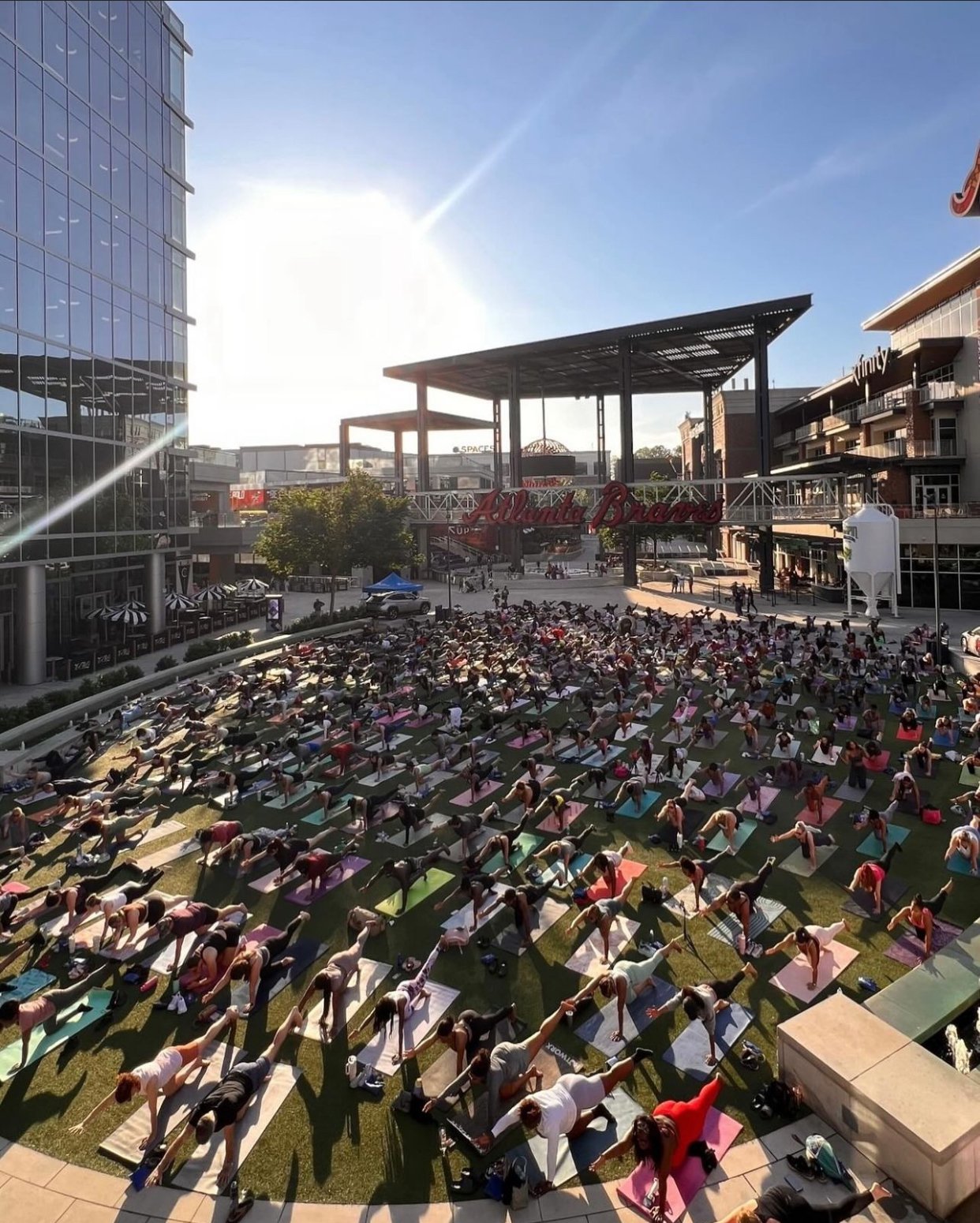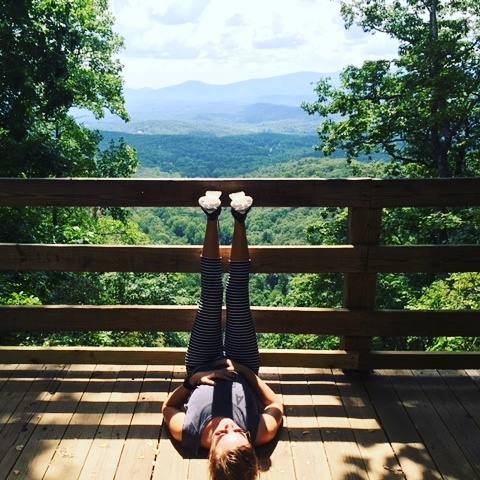
our wisdom
Trauma Informed Yoga for Self-Regulation
Trauma informed yoga for self-regulation
Self-regulation refers to our ability to manage and control our thoughts, emotions, and behaviors in response to different situations. It involves maintaining a sense of equilibrium, even amidst external stressors or internal challenges. Self-regulation empowers us to navigate through life's ups and downs with composure, resilience, and adaptability.
Yoga practice can be the most accessible tool that we can use to self-regulate.
Check out a 30-minute yoga practice with me that can serve as a helpful tool amidst chaotic time.
Trauma-informed yoga for self-regulation.
Breathe Your Way To Stress Reduction
Belly breathing, also known as diaphragmatic breathing or deep breathing, is a technique that involves engaging the diaphragm to maximize the amount of oxygen taken in and carbon dioxide expelled during each breath.
Belly breathing, also known as diaphragmatic breathing, is a technique that involves engaging the diaphragm to maximize the amount of oxygen taken in and carbon dioxide expelled during each breath. Belly breath has numerous benefits for physical and mental well-being. Here are some benefits of belly breathing, supported by reputable resources:
Stress reduction: Belly breathing activates the body's relaxation response and helps reduce the production of stress hormones like cortisol. It can promote feelings of calmness and relaxation, alleviating anxiety and tension.
Resource: Harvard Health Publishing - Relaxation techniques: Breath control helps quell errant stress response.
Improved respiratory function: Belly breathing helps to strengthen the diaphragm and enhances lung capacity. It allows for deeper and more efficient breathing, leading to increased oxygen intake and better oxygenation of the body.
Resource: Journal of Clinical Medicine - Diaphragmatic Breathing Reduces Exercise-Induced Oxidative Stress.
Enhanced focus and mental clarity: Deep breathing techniques, such as belly breathing, increase oxygen flow to the brain, which can improve concentration, mental alertness, and cognitive performance.
Resource: Frontiers in Psychology - Acute effects of slow-paced breathing on task performance and mood in participants with mild cognitive impairment.
Stress and anxiety management: Belly breathing has been found to have a positive impact on managing symptoms of anxiety disorders, such as panic attacks, social anxiety, and generalized anxiety disorder.
Resource: Journal of Clinical Psychology - Breathing Training: A Promising Intervention for Panic Disorder.
Lowered blood pressure: Deep breathing techniques, including belly breathing, have been associated with reduced blood pressure levels. It can be beneficial for individuals with hypertension or those at risk of developing high blood pressure.
Resource: American Heart Association - How to Measure Blood Pressure Using a Manual Monitor.
Improved digestion: Deep abdominal breathing stimulates the parasympathetic nervous system, promoting relaxation and aiding digestion. It can help reduce symptoms of digestive disorders, such as irritable bowel syndrome (IBS) and indigestion.
Resource: Gut - Breathing training improves symptoms and quality of life in patients with functional gut disorders.
Check out a two minute video guide to belly breathing here.
Irina
Discover the Deep Relaxation and Healing Benefits of Yoga Nidra
Yoga Nidra is a guided meditation technique that promotes deep relaxation and stress reduction. Scientific studies have shown that regular practice of yoga nidra can improve overall well-being, cognitive function, and immune system function, as well as treat conditions such as PTSD and chronic pain. This post explores the benefits of yoga nidra and provides tips on how to practice it effectively.
Yoga Nidra is a form of guided relaxation and meditation that is often referred to as "yogic sleep." It is a technique that allows the body and mind to completely relax while remaining conscious and aware.
During a Yoga Nidra practice, participants lie down comfortably and follow the guidance of a facilitator. Yoga Nidra facilitator will lead everyone through a series of visualizations and body awareness exercises, breathwork, visualization, and relaxation techniques, designed to induce a state of deep relaxation and heightened awareness.
Yoga nidra practice has been scientifically proven to have many benefits for both physical and mental health. Studies have shown that regular practice of yoga nidra can reduce stress, anxiety, depression, and insomnia, as well as improve overall well-being, cognitive function, and immune system function. Additionally, yoga nidra has been used as a therapeutic tool to treat conditions such as PTSD, chronic pain, and substance abuse.
If you are interested in giving Yoga Nidra practice a go click here to experience a 10-minute Yoga Nidra To Reset The Nervous System.
Here are some sources for the benefits of yoga nidra studies:
Yoga Nidra as a Therapeutic Intervention for Military Veterans with PTSD: A Randomized Controlled Trial. Journal of Clinical Psychology, 2014. https://onlinelibrary.wiley.com/doi/abs/10.1002/jclp.22081
Yoga Nidra relaxation increases heart rate variability and is unaffected by a prior bout of Hatha yoga. Journal of Alternative and Complementary Medicine, 2011. https://www.ncbi.nlm.nih.gov/pmc/articles/PMC3151418/
Exploring the Therapeutic Effects of Yoga Nidra on Chronic Pain: A Clinical Case Series. International Journal of Yoga Therapy, 2018. https://www.ncbi.nlm.nih.gov/pmc/articles/PMC6390488/
Effect of Yoga Nidra on Blood Glucose Level in Diabetic Patients. International Journal of Yoga, 2013. https://www.ncbi.nlm.nih.gov/pmc/articles/PMC3887506/
Effects of yoga nidra on psychological general well-being in patients with menstrual disorders: a randomized controlled trial. International Journal of Yoga, 2021. https://pubmed.ncbi.nlm.nih.gov/34084363/
Irina
Pain is inevitable. Suffering is optional.
Trauma is an unfortunate experience that happens to many of us. It can be caused by a wide range of events, including abuse, neglect, violence, and accidents. Trauma can have a severe impact on a person's mental and physical well-being. Fortunately, there are many ways to heal from trauma, and yoga is one.
Yoga is a mind-body practice that has been around for thousands of years. It combines physical postures (asanas), breathing techniques (pranayama), and meditation to improve physical and mental health. While yoga is often practiced for its physical benefits, it has also been shown to be an effective tool for healing trauma.
Studies have shown that practicing yoga can help reduce symptoms of post-traumatic stress disorder (PTSD) and other trauma-related disorders. A 2019 study published in the Journal of Traumatic Stress found that women who practiced yoga had significant reductions in PTSD symptoms, including intrusive thoughts and avoidance behaviors. Another study published in the Journal of Alternative and Complementary Medicine found that yoga reduced symptoms of depression, anxiety, and PTSD in military veterans.
One of the reasons that yoga is effective in healing trauma is that it helps regulate the body's stress response. Trauma can cause the body's stress response system to become overactive, leading to chronic stress and other negative health outcomes. Yoga helps activate the parasympathetic nervous system, which promotes relaxation and reduces stress.
Additionally, yoga can help improve emotional regulation and increase feelings of self-efficacy and empowerment. Trauma can leave individuals feeling powerless and out of control. Yoga can help individuals feel more in control of their bodies and their thoughts, which can be a powerful tool in healing trauma.
Yoga is also a safe and accessible practice for many individuals. It can be practiced alone or in a group setting, and there are many different styles of yoga to choose from. Additionally, yoga can be modified to fit the needs and abilities of each individual.
In conclusion, yoga is a powerful tool for healing trauma. It has been shown to be effective in reducing symptoms of PTSD and other trauma-related disorders, regulating the body's stress response, and improving emotional regulation and feelings of empowerment. Yoga is a safe and accessible practice that can be customized to fit the needs of each individual. If you or someone you know has experienced trauma, consider incorporating yoga into your healing journey.
References:
van der Kolk BA, Stone L, West J, et al. Yoga as an adjunctive treatment for posttraumatic stress disorder: a randomized controlled trial. J Clin Psychiatry. 2014;75(6):e559-565.
Steiner JL, Glombiewski JA, Müller-Feldmeth D, et al. Efficacy of yoga for posttraumatic stress disorder: a systematic review and meta-analysis of randomized controlled trials. J Clin Med. 2021;10(3):449.
Gallegos AM, Crean HF, Pigeon WR, Heffner KL. Yoga practice improves executive function by attenuating stress levels. Biol Psychol. 2019;148:107776.
Staples JK, Hamilton MF, Uddo M. A yoga program for the symptoms of post-traumatic stress disorder in veterans. Mil Med. 2013;178(8):854-860.
Park CL, Groessl EJ. Exploring the benefits of yoga for veterans with posttraumatic stress disorder. J Altern Complement Med. 2014;20(5):A54.
Harness the Power of Bhu Mudra
Have you ever wondered how simple hand and finger movements can possibly make an impact on our state of wellbeing? Mudras, or mindful gestures with your hands and fingers, have the power to do just that!
One of my personal favorites is Bhu Mudra also known as the Mother Earth Gesture or Prithvi Mudra. It is a simple hand gesture used in meditation and yoga practice for grounding and connection to the earth. It is believed to help calm the mind, body and promote relaxation.
To practice this mudra, gently bring your pinky and ring finger to the tip of your thumb while keeping your pointer and middle finger extended. Then, place your extended finger tips on the ground (or some other surface). Practice comfortable breath & hold this mudra for 1 minute while being aware of your connection with earth.
*With this practice, it helps if you can visualize energy traveling from your fingertips through the ground and up into your body.
Regularly practicing Bhu Mudra has many benefits including reducing stress, calming anxiety, improving concentration, boosting creativity, increasing energy levels, and promoting inner peace. Additionally, it helps strengthen our spiritual connection with nature by allowing us to tap into its powerful energy source for healing purposes.
Legs Up the Wall: The Ultimate Relaxation Posture
If you practice one yoga posture a day practice this one
Have you heard of Legs Up the Wall (Viparita Karani) pose? It's a restorative yoga posture that can bring about deep relaxation and help with stress relief. Even better, this pose has amazing benefits for your lower back health! Let's take a look at what Viparita Karani is all about.
What is Legs Up the Wall?
Legs Up the Wall (Viparita Karani) is a gentle inversion pose that helps to relieve stress and promote relaxation. To practice this pose, you will need something to prop up your legs (like a wall or chair) and a yoga mat or blanket for support. Once you are ready, lie on your back and place your legs against the wall, making sure that your hips are close to the wall. You can also place a cushion or bolster under your hips for added comfort. Relax into this posture for at least five minutes and breathe comfortably. This quick practice will help to reduce stress, calm your mind, and improve circulation throughout your body.
Lower Back Health Benefits of Viparita Karani
This restorative yoga posture can also be beneficial for lower back health as it helps to stretch out tight muscles surrounding the back area. By stretching out these muscles, Viparita Karani can help to alleviate lower back pain and tension while promoting blood flow in the area. It can also help improve flexibility in your hips and spine which can further reduce lower back discomfort over time.
Viparita Karani is an incredibly versatile pose that offers numerous benefits both physically and mentally! Not only does it promote relaxation by calming the mind, but it can also provide relief from lower back pain while improving overall flexibility in the hips and spine. So if you’re looking for an easy way to unwind after a long day or just want to take some time for self-care, don’t forget about Legs Up the Wall! Give it a try today!
A Guide to Restorative Yoga for Stress Reduction
The most obvious benefit of restorative yoga is its ability to reduce stress and tension in the body. It can help lower cortisol levels—the hormone associated with stress—which can have a positive effect on overall health and wellbeing.
Stress, anxiety, and tension are all-too-common experiences in our modern lives. We’re constantly being pulled in different directions and pushed to our limits. But there is hope! Restorative yoga is a great way to reduce stress and promote relaxation. Let's explore why restorative yoga is so beneficial for stress reduction.
What Is Restorative Yoga?
Restorative yoga is a type of yoga practice that helps your body relax deeply, using props such as blankets, bolsters, and blocks to support your body in various poses. This allows you to stay in the pose longer while still being comfortable, allowing you to stretch more deeply than if you were just holding the pose on your own. The use of props also makes it easier to relax into the poses, which helps you let go of any tension or stress that might be stored in your body.
The Benefits of Restorative Yoga
The most obvious benefit of restorative yoga is its ability to reduce stress and tension in the body. It can help lower cortisol levels—the hormone associated with stress—which can have a positive effect on overall health and wellbeing. Additionally, restorative yoga can help improve sleep quality by relaxing the mind and calming racing thoughts that often occur at night when trying to fall asleep. Finally, restorative yoga can help increase flexibility by stretching out tight muscles and connective tissues over time.
Creating a Restorative Practice
Creating a successful restorative practice takes some planning but is totally doable! Start by finding a comfortable place where you won't be disturbed for at least 15 minutes; this could be your bedroom or living room or even outside under a tree if weather permits! Set up your space with all the props you need for each pose; blocks for support under hands or feet, blankets for extra cushioning on joints like knees or elbows, straps for stretching arms behind the back, etc… Once everything is set up it's time to start moving! Use slow movements—like standing up from one pose (like mountain pose) then slowly bowing forward into downward facing dog before transitioning into child's pose—to get into each position while focusing on breathing deeply into each movement. Stay in each position anywhere from 5-15 minutes depending on what feels right for your body before slowly transitioning out of each posture back into mountain pose then finally lying down onto the floor with legs stretched out wide open palms facing up towards ceiling staying here until end of practice.
Restorative yoga can provide great relief from both physical and mental tension & stress allowing us to gain control over our bodies & minds so we can live more happily & healthily no matter how stressful life may seem at times. With proper preparation & practice we can create successful restorative practices that will make us feel relaxed & rejuvenated every single time we move through them! So take some time today—even if it’s just 5 minutes—to practice restorative poses & start feeling better today!
Flow & Let Go Yoga Practice
Mellow Yoga Flow
Hi friends,
Join me for a 30-minute mellow practice. You will need a yoga mat, two blocks (or books) and a bolster (or a pillow).
Remember to connect with us on instagram @ibyogabarre.
Namaste
Irina












